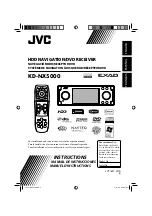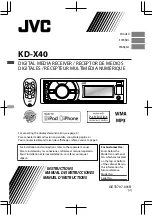
English
|
3
Warning Messages
For safe usage please observe the following !!!
READ THIS MANUAL FIRST
Read this manual carefully before starting to operate the
Kenwood Car Navigation System and follow the manual's
instructions. Kenwood are not liable for problems or accidents
resulting from failure to observe the instructions in this manual.
OBSERVE LOCAL TRAFFIC SIGNS AND REGULATIONS
Always observe the local traffic signs and regulations when
driving and check them against the system's instructions.
Due to frequent changes in local signs and regulations, the
traffic sign and regulation data on the Map DVD-ROM may be
outdated. Furthermore the Map DVD-ROM cannot reckon with
certain conditions such as traffic density at certain times of
the day, (temporary) road closures due to construction work,
weather conditions or special events taking place.
Therefore
always obey the local traffic signs and regulations rather
than the system's instructions. Failure to do so may place
you in illegal, unsafe or dangerous situations.
DRIVE SAFELY
Before following the system's guidance instructions, such
as changes in direction, always check first whether it is safe
to do so given the current traffic conditions.
Then follow the
given instructions, but make sure you do so in a safe manner.
VOLUME LEVEL
Keep the system's volume at a low enough level to be able to
hear outside noises whilst driving. If you can no longer hear
outside noises, you may be unable to react adequately to the
traffic situation. This may cause accidents.
FOREIGN OBJECTS
Keep fingers and foreign objects out of the disc-loading slot, so
as not to cause accidents. In the event of there being foreign
objects inside the unit, or smoke or noxious odours coming out,
stop operation immediately and contact the closest Kenwood
dealer.
STOP OPERATION IN THE EVENT OF PROBLEMS
In event of problems such as a
lack of sound or video occurring,
stop operation and push the reset
button. Should the problems
persist, stop operation of the
system and contact the closest
Kenwood dealer.
When upgrading the program,
insert the version-up disc and press
the reset button.
NEVER DISASSEMBLE OR ALTER
Never try to disassemble or alter the navigation equipment. Any
attempt to do so may cause accidents, fire or electric shock.
REPLACING FUSES
When replacing fuses always use the same rated ampere. Failure
to do so may cause fire.
SMALL ARTICLES
Keep small articles (like screws or batteries) out of the reach of
children. If any such object is accidentally swallowed, consult a
doctor immediately.
Information in this document is subject to change without
notice.
The illustrations of the display and the panel appearing in this
manual are examples used to explain more clearly how the
controls are used. Therefore, what appears on the display in
the illustrations may differ from what appears on the display
on the actual equipment, and some of the illustrations on
the display may represent something impossible in actual
operation.
Before Use
Start the car engine before use
This mobile navigation system can be used when the ignition
key is turned to ON or ACC. However, to preserve the battery,
it should be used with the engine running whenever possible.
Using the navigation system for a long time with the engine
switched off can cause the battery to run down.
Time before current position is displayed
The mobile navigation system will not display the correct current
position of the vehicle the first time it is used after purchase, or
if the battery has been removed for a long time. GPS positioning
signals will soon be received, however, and the correct position
will be displayed.
Reading programmes after the battery has been turned off
The navigation programmes will be deleted if the battery
is removed for repairs, etc. If this happens, set the map disc
provided into the mobile navigation system and switch on the
engine. The mobile navigation system will automatically load the
programmes and start operating normally again.
When driving on rough roads
The mobile navigation system might not operate properly or be
able to read map data from the disc if there is severe vibration
caused by driving on rough roads.
Handling the GPS antenna
• Do not paint the antenna. This will impair or disable signal
reception.
• Remove any object or accumulated snow, etc., from the top of
the antenna. It will reduce reception strength.
• Do not pull the cord when removing the antenna or adjusting
its position. This can cause a short or snap the wires.
Operating whilst driving
The GPS voice navigation system displays the switches disabled
during driving in fainter colors. These switches stop functioning
and no message is displayed.
Precautions for handling precision machines
Be careful of the surrounding temperature. Using the mobile
navigation system at extremely high or low temperatures can
lead to malfunction or damage.
Also note that the unit can be damaged by strong vibration or
by metal objects or water getting inside.
Condensation
Condensation can form on the lens inside the main unit just
after the car heater is switched on in cold weather, for example,
leading to malfunction. The main unit will start working
normally again if it is just left alone for about one hour for this
condensation to go away. If normal operation is not restored
after several hours, return the main unit to the store where you
purchased the mobile navigation system.
Map disc
Always replace the map disc with another compatible map disc.
Never insert an incompatible disc. It can damage the main unit.
Precautions when Handling Map Discs
• You should handle discs carefully, as excessive warping or
scratches on the disc surface or label can lead to reading errors.
• Store discs away from direct sunlight. The disc might warp and
become unusable.
• Lightly wipe the disc with a soft cloth in a straight line from
the centre of the disc towards the outer edge.
• If you touch the data surface of a disc (the surface without a
label printed on it) it might get dirty and lead to a malfunction.
Always hold a disc either by its centre hole and an edge or by
two edges.
• Do not write on, or stick paper or seals onto, the surface of a disc.
• Never clean discs with benzene, thinners, record spray, anti-
static spray or chemical swabs.
• Map discs rotate at high speed inside the main unit. Do not
use a cracked or badly warped disc, therefore, because it might
damage the main unit.
Safety precautions
KNA-2600̲r3.0̲English.Indd 3
03.12.4, 10:28:03 PM




































